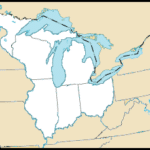
Plessy v. Ferguson APUSH questions show up frequently on the exam. This is one of those “landmark” Supreme Court cases that you really need to know. The impact of this decision was huge. It basically defined racial policy in the period between Reconstruction and the Civil Rights Movement. Read on for everything you need to know about Plessy v. Ferguson for the AP US History exam.
What is Plessy V. Ferguson?
Plessy v. Ferguson is a key Supreme Court case in U.S. history. It shaped racial policy in the United States for over half a century by upholding the legality of racial segregation.
Case background:
In 1890, Louisiana passed the Separate Car Act, which required separate cars for blacks and whites on railroads. A civil rights activist group decided to test the law. They wanted someone to get arrested on the basis of this law so they could challenge the law in court, hoping to get it overturned. Homer Plessy was their test case. Plessy was a free-born, mixed race man, and though his heritage was ⅞ European and only ⅛ African, under the law, he was classified as black and would have to ride in a “black-only” railcar. In 1892, the group got Plessy to buy a ticket, seat himself in a white car, and get arrested on purpose.
The case went to trial, first at the state level in a case known then as Homer Plessy v. State of Louisiana. Plessy’s lawyers argued that the state law failed to protect his rights and was in violation of the 13th and 14th Amendments. The judge, John Howard Ferguson, disagreed, ruling that the state had the right to regulate railroads that operated within state boundaries. Plessy was found guilty and charged a fine.
The case was appealed again and again until it finally reached the U.S. Supreme Court in 1896.
The decision:
In a 7-1 decision, the Supreme Court upheld the earlier decision of the lower courts and ruled against Plessy. The justices argued that the Louisiana law did not violate the 14th Amendment, nor did it imply the inferiority of blacks. Instead, they said that states had the right to make public policy involving racial segregation, assuming accommodations were “separate but equal.”
Important year to note for Plessy V. Ferguson:
1896 (the year of the Supreme Court decision)
Why is the Plessy V. Ferguson case so important?
Plessy v. Ferguson provided a legal justification for racial segregation. It essentially gave the green light to Jim Crow.
The impact of this case went well beyond railcars. Now that “separate but equal” was deemed perfectly legal and constitutional, many states went crazy with it, segregating everything from schools and restaurants to water fountains and restrooms and everything in between. Also, even though “separate but equal” was the standard they claimed, this often wasn’t really the case. Facilities designated for blacks were often of lower quality than those meant for whites.
These policies remained on the books all the way until the mid-1900s. The “separate but equal” doctrine remained the law of the land in many places until it was overturned by the Supreme Court in the 1954 case of Brown v. Board of Education.
What are some historical people and events related to Plessy V. Ferguson?
- Homer Plessy- the defendant
- Jim Crow laws- legal racial segregation upheld by this Supreme Court case
- Brown v. Board of Education– 1954 case that overturned the “separate but equal” doctrine
What example question about Plessy V. Ferguson might come up on the APUSH exam?
“The object of the amendment was undoubtedly to enforce the absolute equality of the two races before the law, but, in the nature of things, it could not have been intended to abolish distinctions based upon color, or to enforce social, as distinguished from political, equality, or a commingling of the two races upon terms unsatisfactory to either. Laws permitting, and even requiring, their separation, in places where they are liable to be brought into contact, do not necessarily imply the inferiority of either race to the other, and have been generally, if not universally, recognized as within the competency of the state legislatures in the exercise of their police power.”
-Majority opinion, Plessy v. Ferguson (Source)
The decision in this Supreme Court case was used to
A) restrict African Americans’ ability to exercise their right to vote.
B) grant citizenship to African Americans, including former slaves.
C) forcibly integrate public schools throughout the United States.
D) justify de jure racial segregation in the public arena.
Answer:
The correct answer is (D). The court decision ruled that separating the races did not inherently imply the inferiority of either race and did not violate anyone’s rights under the 14th Amendment. This was used to justify de jure racial segregation, which took the form of “Jim Crow” laws. Remember, de jure means “according to the law,” so this involved laws that required that the races be segregated. This is opposed to de facto (“in practice”) segregation, which is not part of the law but occurs as a result of other socioeconomic factors (e.g., neighborhoods today that are predominantly one race even though anyone can legally live there).






Leave a Reply